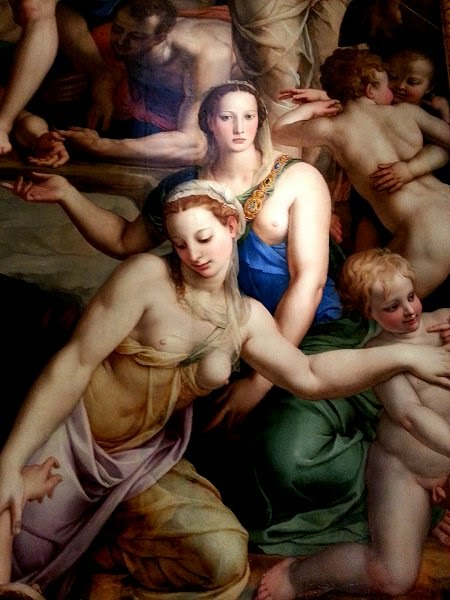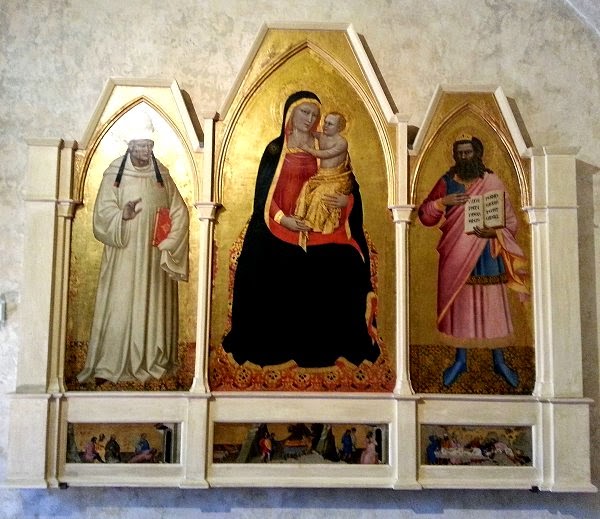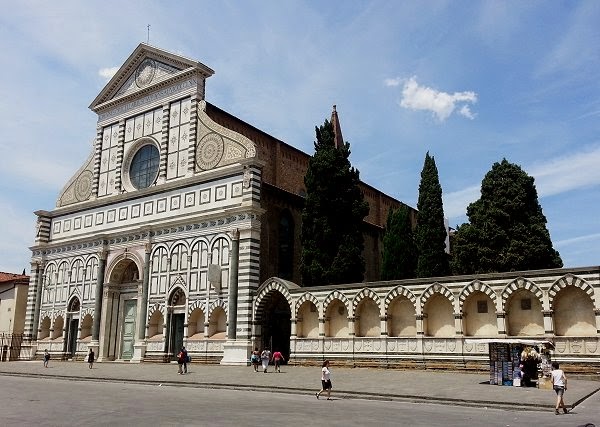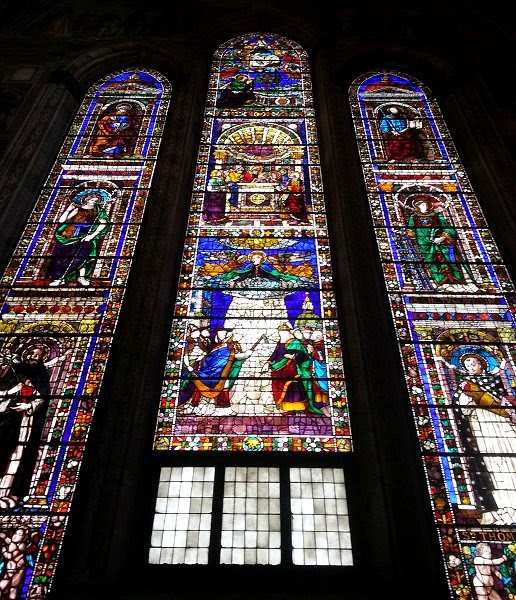The Basilica di Santa Croce ( Basilica of the Holy Cross ) is the principal Franciscan church in Florence and is also referred as the Pantheon of Florence as it is the burial place of some of the most illustrious Italians, such as Michelangelo, Galileo, Machiavelli and Rossini - it is known also as the Temple of the Italian Glories (Tempio dell'Itale Glorie).
The church building dates back to 1294 - but the bell tower was built in 1842, replacing an earlier one damaged by lightning, and the Neo-Gothic marble facade dates from 1857-1863.
The Basilica is the largest Franciscan church in the world and its most notable features inside are its sixteen chapels - many of them decorated with frescoes by Giotti. Legend says that Santa Croce was founded by Saint Francis himself in the first half of the 13th century.
The construction of the current church, to replace an older building, was begun on 12 May 1294, and paid for by some of the city's wealthiest families. It was consecrated in 1442 by Pope Eugene IV.
Tomb of Michelangelo ...
The frescoes were executed by Giovanni Battista Naldini.
Michelangelo’s bust (by Battista Lorenzi) is surrounded by allegorical sculptures representing Sculpture, Architecture and Painting
(the three wreath rings also represent the Arts).
Michelangelo’s bust (by Battista Lorenzi) is surrounded by allegorical sculptures representing Sculpture, Architecture and Painting
(the three wreath rings also represent the Arts).
... detail ...
The Pope wanted to bury Michelangelo in Rome, but as he had promised his
body to Florence ( even though he had not lived in Florence for 30
years ), the Florentines stole his body in the middle of the night and
moved it to Florence in a horse cart. Needless to say, this annoyed the
Pope somewhat.
The Cenotaph to Dante Alighieri ( 1265 - 1321 )
by Luigi Cambray Digny
and created by Stefano Ricci in 1829
Florence tried several times to convince Ravenna to return his remains ( even sending a military expedition, at which point the people of Ravenna hid his bones in the walls of the monastery ). Michelangelo offered to create a monument on the eve of one of these attempts, but the Florentine Signoria refused to accept it as they were not yet ready to rehabilitate his memory (more than 200 years after he died).
The front of the cenotaph reads “Onorate L’Altissimo Poeta”, roughly: “Honor the Poet of the Highest Regard”. Of course, the authorities even at the time this cenotaph was created still did not have enough regard for Dante to expunge his order of exile and death sentence on trumped-up charges that were created by his enemies. Florentines are the world champions at holding a grudge.
The Cenotaph to Niccolo Machiavelli ( 1469 - 1527 )
Tomb of Galileo Galilei ( 1564 - 1642 )
created by Giovanni Battista Foggini
Galileo improved the telescope and made important astronomical observations and is considered to be the father of modern observational astronomy, as well as the father of
modern physics, science, and modern science. He discovered the four largest moons of Jupiter
(Galilean moons), worked in applied science, improving the compass, and was an pretty amazing fellow.
Unfortunately, his view of the Solar System was very
unpopular with the Catholic Church’s Inquisition ... ( who had condemned Heliocentrism, the notion
that the Earth was not the center of the Universe, as “false and contrary to Scripture”).
Galileo
was tried by the Inquisition, found “vehemently suspect of heresy”, forced to recant, and spent
the rest of his life under house arrest. For hundreds of years the Catholic Church banned his
writings, and the Church even stopped Grand Duke Ferdinando II de’ Medici from burying him
in the main body of Santa Croce and erecting a monument because he had been condemned.
As late as 1990, Cardinal Ratzinger concluded that the verdict against Galileo was rational and just,
but in 1992 Pope John Paul II expressed regret over how the Church had handled the affair, conceding
that the Earth was not stationary, the result of an extensive Church study. The Church does move slowly.
Tomb of Gioachino Rossini ( 1792 - 1868 )
... I couldn't find any arguments with any popes -
he was the idol of the Italian opera goers ...
... I couldn't find any arguments with any popes -
he was the idol of the Italian opera goers ...
A monument to Florence Nightingale stands in the cloister,
in the city in which she was born and after which she was named.
in the city in which she was born and after which she was named.
Battista di Marco Del Tasso - 1540
... detail ...
... detail ...
Annunciation - Giorgio Vasari - 1570
Entrance from the Cloisters ...
The Assumption of the Virgin - Giuseppe Bezzuoli - 1840
Belltower from the Cloisters ...
In 1866, the
complex became public property, as a part of government suppression of
most religious houses, following the wars that gained Italian
independence and unity.
In 1966, the Arno River flooded much of Florence, including Santa Croce.
The water entered the church bringing mud, pollution and heating oil.
The damage to buildings and art treasures was severe, taking several
decades to repair.
---------------------------------------------
My next refuge from the heat was ...
The Basilica Santa Maria Novella
Reliquary busts of Saint Ursula and one of the eleven thousands virgins of Cologne ( ??? ) ... both by unknown artists from 14th century ...
Cloisters ...
Cloisters ...
----------------------------------------------------
and then finally as the midday heat seared down,
I took a bus ride up through the cool leafy suburbs
into the hills above Florence to visit ...
From here it was down the steps to the bus stop and two rides later I was home
and under the cold shower in an attempt to re-hydrate myself ...
and I thought Australia got hot ... !!! ...
The Basilica Santa Maria Novella
Santa Maria Novella is the first great basilica in Florence, and is the city's principal Dominican church.
The church, the adjoining cloister, and chapterhouse contain a store of art treasures and funerary monuments. Especially famous are frescoes by masters of the early Renaissance.
The church was finished in 1360 and consecrated in 1420 and the inlaid black and white marble facade of the church completed in 1470.
Much of the
artworks were financed through the generosity of the most important
Florentine families, who ensured themselves of funerary chapels on
consecrated ground.
Reliquary busts of Saint Ursula and one of the eleven thousands virgins of Cologne ( ??? ) ... both by unknown artists from 14th century ...
Cloisters ...
Cloisters ...
----------------------------------------------------
and then finally as the midday heat seared down,
I took a bus ride up through the cool leafy suburbs
into the hills above Florence to visit ...
The Basilica San Miniato al Monte
(St. Minias on the Mountain)
This is a Romanesque
basilica standing atop one of the highest points in Florence.
Saint Miniato was an Armenian prince serving in the Roman army under
Emperor Decius. He was denounced as a Christian after becoming a hermit
and was brought before the Emperor who was camped outside the gates of
Florence. The Emperor ordered him to be thrown to beasts in the
Amphitheatre where a panther was called upon him but which refused to
devour him.
Beheaded in the presence of the Emperor, he is alleged to have picked up
his head, crossed the Arno River and walked up the hill of Mons
Fiorentinus to his hermitage. A shrine was later erected at this spot
and there was a chapel there by the 8th century.
Construction of the
present church was begun in 1013 and it was endowed by the Emperor Henry
II. The adjoining monastery began as a Benedictine community, then
passed to the Cluniacs and then in 1373 to the Olivetans, who still run
it.
The frugal monks keep most of the lights switched off during the day, and flash photography is not allowed - so photographing the beautiful frescoes at the back of the church didn't work unfortunately ...
The monks make famous liqueurs, honey and herbal teas - which they
sell from a shop next to the church.
The city lies at the feet of the Basilica ...
The campanile collapsed in 1499 and was replaced in 1523, although it
was never finished. During the siege of Florence in 1530 the complex was used as
an artillery post by the defenders and Michelangelo had it wrapped in
mattresses to protect it from enemy fire.
From here it was down the steps to the bus stop and two rides later I was home
and under the cold shower in an attempt to re-hydrate myself ...
and I thought Australia got hot ... !!! ...


















































No comments:
Post a Comment
Note: Only a member of this blog may post a comment.